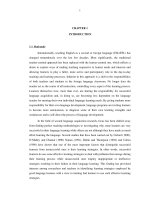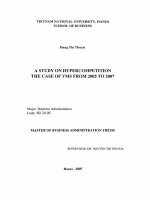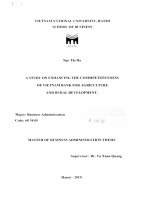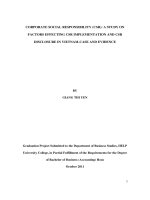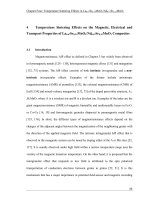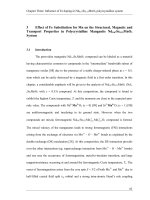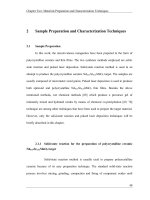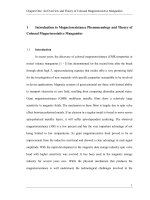A Study On Why The United States Must Be Cautious In Attempts To Accelerate Appreciation Of The Rmb
Bạn đang xem bản rút gọn của tài liệu. Xem và tải ngay bản đầy đủ của tài liệu tại đây (482.41 KB, 113 trang )
A STUDY ON WHY THE UNITED STATES MUST BE CAUTIOUS IN
ATTEMPTS TO ACCELERATE APPRECIATION OF THE RMB
CHAPTER ONE
1.1 INTRODUCTION
Napoleon once stated that, “When China wakes, it will shake the world.”1 Since
Deng Xiaoping’s declaration of an “Open Door Policy” in 1979, the Chinese economy
has experienced tremendous economic growth that has been unmatched by any modern
country. 2 In addition, the way at which the country has sustained record growth over a
relatively constant period is remarkable. This incredible growth has not only been
beneficial for China, but also essential for the United States and numerous economies
throughout the international community.
According to the U.S.-China Business Council, China’s real Gross Domestic
Product (GDP) grew 10.7 percent in just 2006 alone.3 This level of economic expansion
in one year equates to the aggregate growth many countries would amass over an entire
decade. Also impressive is the fact that, less than a decade ago, China was the seventh
largest economy before surpassing Italy, France, and the United Kingdom. Furthermore,
when you consider purchasing-power parity (PPP) of this budding economy, by most
measures, China is regarded as the second largest economy. Taking these facts into
account, there should be no doubt that China’s economy is awakening, and as the world’s
fourth largest economy behind the United States, Japan, and Germany, China still has
ample room for expansion. 4
1
Gittings, John. (2005) Half a Superpower: pg 134
Deng Xiaoping was a prominent Chinese politician and reformer, and the late leader of the Communist
Party of China (CCP). Deng never held office as the head of state or the head of government, but served as
the de facto leader of the People's Republic of China from 1978 to the early 1990s.
3
See General and Financial Indicators of the People's Republic of China
4
See Walker, Marcus (2007) China’s GDP Poised to Top Germany’s as Power Shift Speeds Up
2
1
In recent years, China’s thriving economy has also begun to produce an
unprecedented number of middle class families. 5 As a result, the average Chinese today
has some ten times the purchasing power they had just a quarter century ago. Many
analysts believe that at this rate China could potentially reach the purchasing power of the
U.S. in about two decades and surpass the economic superpower in about three decades. 6
1.2 STATEMENT OF THE PROBLEM
While China is enjoying economic expansion, a growing middle class, and
increased trade relations, the United States is simultaneously experiencing quite the
opposite phenomenon. Moreover, the United States, through a robust bilateral economic
exchange with China over the past decade, has experienced an unprecedented trade
deficit, increased levels of unemployment, surging energy costs, and a middle class that
appears to be shrinking due to widening disparities between the rich and poor. As a
result, more and more lawmakers and policy analyst have become frustrated with
economic policies that appear to give China an unfair advantage over the U.S., thus
increased attention is now focused on the way at which China is regulating its currency.
Given that a significant deceleration of the Chinese economy is not expected in
the near future, there are important currency valuation issues that should be addressed to
ensure a more balanced U.S.-Sino relationship. Many policy makers believe that an
undervalued renminbi7 (RMB) is harmful to the U.S. economy and more specifically the
running U.S. trade deficit with China.8 Indeed, increased trade with China plays a
5
See Faux, Jeff (2006) The Global Class War
See The Economist (2002) To Get Rich Is Glorious
7
The renminbi is the currency of the mainland of the People's Republic of China whose principal unit is the
yuan.
8
See Morrison, Wayne & Labonte, Marc (2008) China’s Currency: Economic Issues and Options for U.S.
Trade Policy
6
2
significant role in decreasing the cost for many goods sold throughout the United States,
which simultaneously benefits both the American and Chinese economies. However, an
extremely undervalued currency has augmented the steady and overwhelming flow of
cheap goods from China and has made it difficult from U.S. companies to compete. It
has also been argued that since an undervalued RMB equates to cheaper goods and
services, this in turn directly affects the American worker by placing tremendous
downward pressure on their wages. With that said, if China intends to become a trusted
international player, it will need to revalue its currency and implement a more flexible
exchange rate that is fair and reflective of market forces.
However, some economists do not agree that China’s valuation is the problem
behind many of the concerns facing the U.S. economy. In fact, there is concern that U.S.
pressure to encourage China to appreciate the RMB could actually be detrimental to
China’s growing economy. In addition, there is concern that the impact of an ailing
Chinese economy, as the result of a failed currency policy, could impact many economies
throughout the international community. Thus, the stakes are too high for China and the
U.S. to assert a currency policy that is overly ambitious and potentially too aggressive.
Therefore, it is important to know where China is headed with what some
perceive to be its manipulative economic policies; what are the country’s intentions; what
could aggressive pressure from the West mean for US-Sino relations and could this lead
to an inevitable collision? The goal of the research involved in this thesis is to find
answers to these important questions by providing the reader a historical analysis of the
evolution of the RMB as well as an assessment of the currency regime China currently
employs.
3
The scope of this study focuses on the current policy debate in Washington as it
relates to China’s currency valuation and the approach that the U.S. should take with
regards to addressing this issue. In addition, it is the intent of this thesis to dissect the
dichotomy of views from the various interests groups and think tanks as well as the very
different policy prescriptions proposed between the Executive and Legislative Branches
of government.
This thesis topic comes at an important time as the international community
becomes ever more integrated and the possibility for crisis is augmented. To this, as
China continues to grow and develop into a dominant fixture within the international
community, the U.S. will have to contend with this fact within its policy
recommendations. In addition, given that China’s influence continues to grow, the
stability of the global economy will become even more contingent on the economic
policies that are implemented from Washington and Beijing. Hence, the topic of this
thesis aims toward offering an understanding that a balanced and mutually beneficial
economic relationship is essential for both countries and the global economy.
The principle argument of this thesis advocates for a balanced policy that
maintain steady political pressure on China for its continued commitment to a gradual
yet steady appreciation of the RMB. In addition, this thesis argues that the U.S. must
push for a policy that will not only prevent the potential for instability but which assists
the continued growth of both economies. Lastly, this thesis finds that the range of policy
proposals that have been introduced are all well intended and aim toward a common
objective. However, policies that advocate for a hasty appreciation of the RMB through
4
retaliatory measures can be excessive in nature and research throughout this thesis proves
that they potentially run the risk of exacerbating the possibility for an economic crisis.
1.3 LITERATURE REVIEW
As speculation regarding the likely benefits or impairments, as it relates to
China’s unprecedented growth, continue to increase, more and more analyst are
beginning to provide important research into this phenomenon which is still evolving
before our very eyes. In addition, Congress has become more aggressive in its approach
toward establishing innovative policies aimed at reconciling the discrepancies that
lawmakers perceive to be the cause for China’s surplus in contrast to a mounting U.S.
deficit. This increase in interest has provided a plethora of prior research that provides a
record of ideas and policy prescriptions, which were beneficial in guiding the
assumptions and primary argument of this thesis.
In an effort to equally scrutinize the dichotomy of views towards U.S. economic
policy with China, this thesis includes research from notable conservative and liberal
think tanks alike. Think tanks of particular interest were those that contribute to the
leading views, which permeate throughout our foreign policy such as the Rand
Corporation, Center for American Progress, the Heritage Foundation, and the Brookings
Institution. As a result of this particular focus, the stark differences between the more
labor focused and business opinions and philosophies as it relates to their proposed
courses of action concerning China’s currency regulation became abundantly transparent.
The information and proposals provided by the think tanks who focused more on
labor were more inclined to advocate for cautious interaction with China. They were in
5
fact more likely to draw attention toward the gloomier side of U.S. involvement with
China and never missed and opportunity to highlight the adverse effects created as a
result of the relationship between the two countries.9 However, the investigative
research that they provide makes significant contributions in analyzing indisputable
problems that pose significant threats if China continues to allow the RMB to be
undervalued. As a result, Center for China Currency Coalition and the Economic Policy
Institute for example, tend to advocate for more protectionist measures concerning trade
in addition to harsh punitive measures created in and effort to essentially force China to
immediately revalue the RMB and enact a more free-floating currency.
Some economists such as Nicolas Lardy for example, appear to be
uncompromising at times in their criticism toward China and its currency regime.
However, they provide strong reasoning as to how serious the affects are to the U.S.
concerning the undervaluation of the RMB. Yet, this thesis finds that their proposed
courses of action lean more toward retribution instead of reconciliation. This could pose
the risk of harming the Chinese economy, which is still developing, and some
economists believe that the RMB may not be ready to float freely and manage the
complexity of a free market. Indeed, China has shown that it is trying to make cautious
reforms in an effort to head in the direction that the US would prefer, but hasty and
premature moves could prove detrimental for this economy and U.S.-Sino relations. To
that end, this thesis found the more labor focused interest groups to be extremely helpful
in providing a thorough assessment of the problems the U.S. faces with China’s slow
embrace of full reform, but falls short of endorsing any particular policy.
9
See Bivens, Josh & Scott, Robert (2006) China Manipulates Its Currency- A response is Needed
6
In contrast, some of the more business-focused think tanks have a propensity to
rely heavily on market forces as opposed to what they deem, drastic government
intervention. They also tend to assert the need for a moderate approach that actually
focuses less on China as the sole problem and more on the need to assist its economy as
it gradually evolves. In fact, the idea that quick action on behalf of the U.S. could
backfire, for example, is a leading theory that advocates for a more cautious approach
toward dealing with China’s currency valuation.10 The research from these interest
groups was extremely helpful in understanding the reasoning behind China’s resistance
to hasty reform. It also provided balance to this thesis by highlighting the many benefits
the economic relationship offers the U.S.
It is important to note however, that both the labor and business focused think
tanks and interest groups recognize that there are challenges with regards to China’s
currency regime. While they tend to differ in their demonstration of the severity of the
challenges, both however, propose solutions that are essential in trying to create a
balanced approach to deal with this issue.
In addition to think tanks, when you consider the policies of the Executive
branch versus that of Congress you find that there are clear differences between the two
branches of government. Many analysts have observed that whether there was a
Democrat or Republican in the White House, there has been a difference in views
between the two branches.11 However, similar to the competing views of various think
tanks, both branches have well intended solutions for a common problem. This thesis
takes advantage of the abundant resources from government agencies such as the
10
See Overholt, William (2007) The Cost of Unleashing China’s Currency
See Bader, Jeffery & Bush, Richard (2008) Contending with the Rise of China: Build on Three Decades
of Progress
11
7
Congressional Research Service and the U.S.-China Economic and Security Review
Commission, which provide detailed reports of U.S. interaction with China. This data is
particularly important as it provides up-to-date analysis, which is critical to preserving
the relevancy of the research provided in this thesis.
Lastly, it is important to note that this thesis includes economic statistics and data
primarily based on information from the Chinese Government, which is known to
misrepresent or misreport some of its economic data. This is a limitation faced by all
researchers and analysts examining the Chinese economy. Although the reliability of the
data is somewhat questionable, it is the best and sometimes the only economic
information available for an analysis of this type. The Heritage Foundation Report, The
2008 Index of Economic Freedom, ranks China 126th out of 157 countries whose
economies were assessed for economic freedoms.12 In addition, the Heritage Report
ranked China 23rd out of the 30 countries in the Asian-Pacific Region. The lack of
transparency this represents provides a level of difficulty with regard to gathering
economic data upon which to base sound conclusions on China's economic progress. It
also represents another problem that China must addresses as they strive to become a
market economy. Nevertheless, the arguments and overall conclusions in this thesis are
based on a compilation of research, records, data and an analysis that does not only rely
on the figures provided by official Chinese government sources.
1.4 THESIS OUTLINE
China’s currency structure is complex and thus, fully comprehending the
dynamics require the reader to understand how it evolved to its current form. Therefore,
this thesis begins by providing the reader with a chronological account of the stages at
12
See The Heritage Foundation (2008) Index of Economic Freedom
8
which China’s currency regime has developed. The scope of this assessment focuses
solely on the era of reform, which began in 1979, as this was the period when China
initiated its first major currency reform after Deng Xiaoping’s economic reforms.
Upon garnering an understanding of China’s currency evolution, the reader will
become familiar with the three major exchange rate reforms, the dual exchange rate,
fixed or pegged exchange rate, and currency basket regime. As a result, the reader will
also be able to understand the intricacies of the current system in place. Chapter two is
particularly important because it establishes the foundational knowledge of China’s
exchange rate policy, which will enable the reader to properly evaluate and judge the
opinions and recommendations of critics and leading policy makers provided throughout
this thesis.
Chapter three provides an assessment of the policy implications that China’s
currency valuation present to the U.S. economy. This chapter includes an overview of
the leading theories and assertions as to the exact effect, good and bad, that China’s
economic policy has on the American economy, specifically jobs and the mounting trade
deficit. As such, the reader could find this section to be subjective in nature as it displays
views that are prominent within the liberal and conservative mainstream respectfully.
Chapter four includes a detailed case study that evaluates Japan’s similar
experience with U.S. pressure to appreciate its currency during the 1970s and 1980s.
This includes a detailed historical evaluative of the major policies that were implemented
in an effort to provide a remedy for the U.S.-Japan imbalances during that time. The
effects of these polices on Japans economy is also examined. Furthermore, this case
study yields strong inferences from which it is possible to postulate the potential effects
9
that premature and hasty appreciation may have on China’s economy and long term
development. The accumulation of research provided in this section is valuable and
offers the reader an understanding of what options are plausible and what decisions could
backfire according to history and prior attempts.
The remainder of this thesis focuses on the primary purpose of this research,
which is to observe the policy options and opportunities that could provide the best way
forward toward a balanced and mutually beneficial relationship between the U.S. and
China. Accordingly, chapter five evaluates the positions and proposals from both the
Legislative and Executive Branches of government. The reader will find in this chapter
that there are a number of legislative remedies that have been introduced, yet due to
various circumstances, have not become law. However, the emergence of such
legislation indicates a problem, and the fact that many of the bills have not become law
reveals that there is some reluctance to move forward. As such, chapter five attempts to
provide an answer to this issue by also inquiring into the position of the Executive
Branch and remedies that is currently at play. Upon doing so, the reader will soon
understand that both branches have differing views regarding the best way to move
forward with the growing concern of China’s currency regulation thus, aggressive
legislative prescriptions have been kept at bay.
This thesis closes by restating the intended proposal of a balanced policy that
continues to take moderate measures to keep China moving toward a free-floating
currency while also giving it the time necessary to maintain a stable economy. Upon
concluding this research thesis, the reader should have a thorough understanding of
10
China’s currency exchange regime in addition to a comprehensive view of plausible
policy options that attempt to correct the imbalance between the U.S. and China.
CHINA’S THREE STAGES OF CURRENCY REFORM
CHAPTER TWO
11
2.1 INTRODUCTION
Throughout the close of the 20th Century and into the 21st, the Chinese economy
experienced unprecedented levels of growth unmatched by any other developing
economy at comparable stages of maturity. This substantial expansion of China’s
economy has made possible enormous opportunities for justifiable outlays and
investments that will further enhance economic prospects for continued growth.
Moreover, given that China’s 1.3 billion consumers is a gigantic portion of the global
population, it is in the interest of the United States and the international community to see
China prosper.
Following his historic visit to China in 1972, President Nixon and subsequent
Presidents thereafter, all understood the significance of a strong Chinese economy and
US-SINO relationship. In particular, the powerful influence of the two economies was
expected to open new markets and expand prosperity beyond both countries borders.
Fast-forward to over three and a half decades later and it is obvious that the stated
assumptions have largely come to fruition. Despite substantial economic growth in
addition to improved relations with the U.S., considerable increases in China’s foreign
exchange reserves and a mounting trade surplus in contrast to that of a swelling US
deficit has critics calling into question the way at which China regulates its currency.
Since 1980 following Deng Xiaoping’s initial declaration of an “Open Door
Policy,” China’s currency exchange rate has undergone three major reforms that has
changed the level at which the RMB is valued. The three stages of reform consisted of a
dual exchange rate policy, fixed exchange rate or peg policy, and the current
implementation of a currency basket policy. Each are similar in the fact that they all have
12
drawn their fair share of criticism charging that the methodology which determines the
value of the yuan is manipulative and inequitable. However, notwithstanding the fact
that close scrutiny and criticism may be warranted, most critics should agree that China’s
contemporary method of currency valuation has evolved into a more tolerable standard.
Chapter 2 provides a historical evaluative of the evolution of China’s exchange
rate by focusing on its modern currency exchange rate policies and reforms that served as
the antecedent to the current system it currently employs. The subsequent information
should provide the reader a strong illustration of how far China has come since its initial
phases of reform.
2.2 DUAL EXCHAGE RATE REGIME Dual
The utilization of a dual exchange rate is not uncommon in today’s modern
economy however, this method of currency exchange is traditionally exercised by
developing economies, many of which are in need of a particular safety net or cost
effective structure that provides much needed economic relief. Particularly, China’s
decision to convert to a dual exchange rate system was in anticipation of the adjustments
that would ensue as a consequence of the free market reforms that were being
implemented at the time by Leader Deng Xiaoping. Moreover, the complexity of the
market during this period necessitated an exchange rate regime that would facilitate
China’s efforts to boost international trade and business.
Many countries, for the most part, maintain a unified currency valuation regime
that consists of one official exchange rate. However, a number of developing or
economically challenged countries prefer the dual exchange rate system because it allows
13
them the flexibility necessary to modify their rates in a way that is more cost effective for
their economy. In addition to flexibility, this system is unique in the fact that it enables a
country to circumvent the unpredictability of the market by providing significant control
over the risks and probability involved in such a volatile environment. Furthermore, the
ability to manage risk substantially reduces the chances of economic shock, which could
be devastating to many of the already fragile economies. Dual exchange rates are in fact,
expected to give a country a slight edge in the free market as the system amalgamates the
advantages that are accompanied with both a floating and fixed exchange rate regime.
However, some experts assert that the enactment of a dual exchange rate policy
should be employed for transitional purposes only.13 Moreover, the system of a dual
exchange rate was never regarded as an arrangement that should be permanent because it
skews the actual value of goods and services. As such, economies that prolong their
reliance on a dual exchange rate regime will presumably be regarded as a currency
manipulator. As a result, the country would thus run the risk of retaliation from other
nations such as the U.S. who may consider its actions ominous and inconsiderate of the
economic viability of its trading partners. In fact, during the 1980’s the U.S. became so
concerned about rampant currency manipulation that the Congress passed the 1988
Omnibus Trade and Competitiveness Act14 to prevent abuse of the dual exchange rate
system and other manipulative currency regimes. 15 This action by the U.S. Congress
13
See Xiaoqin-Fan, Emma. (2004) A Note on Dual/Multiple Exchange Rates. pg 8
The 1988 Omnibus Trade and Competitiveness Act requires the Treasury Department to determine
whether countries manipulate the rate of exchange between their currency and the Unites States dollar for
purposes of preventing effective balance of payments adjustment or gaining an unfair competitive
advantage in international trade. If manipulation is found, the Department of Treasury is required to
negotiate and end to such practices. It also requires the Department of Treasury to annually report on the
exchange rate policies of foreign countries that have large global current account surpluses and large trade
surpluses with the United States. (Morris; 2008)
15
Morrison, Wayne & Labonte, Marc (2008) China’s Currency: Economic Issues and Options for U.S.
Trade Policy
14
14
would later play a major role in influencing China to make additional reforms to its
exchange rate.
The methodology behind a dual exchange rate system typically consists of a fixed
exchange rate16 that is determined by the government or respective central bank in
addition to an adjustable rate, which is determined by the market, albeit some countries
such as China establish a variety of ways to determine the adjustable rate. This is
accomplished when a different exchange rate is applied to the current17 or financial
(capital) accounts18 of a country’s balance of payments19 (BOP).20 In contrast to a dual
exchange rate system, most countries apply equivalent exchange rates to both accounts of
the BOP. This provides a clear and unambiguous transaction that does not distort a
countries international balance of payments.
The dual exchange rate regime proved to be a successful system for China’s
reforming economy and the country therefore, continued this practice throughout the
entire decade of the 1980s and into the 90s. What particularly made this exchange
regime extremely attractive for China was its ability to devalue the cost of their exports.
This made Chinese exports cheap and thus tremendously appealing to foreign countries
who desired to maintain low prices for goods and services. As such, demand for Chinese
products increased, further providing a desirable boost to the country’s economy.
16
A type of exchange rate policy where a currency's value is matched to the value of another single
currency or to another measure of value, such as gold. As the reference, value rises and falls, so does the
currency pegged to it.
17
The current account is the sum of sales from trade in goods and services, factor income such as dividends
and interest payments from abroad, and transfers from abroad such as foreign aid, grants, gifts, etc.
18
The financial account records transactions that involve financial assets and liabilities and indicates the
functional categories, sectors, and instruments used for international financing transactions.
19
Balance of payments measures the payments that flow between any individual country and all other
countries. It is used to summarize all international economic transactions for that country during a specific
time period, usually a year. The BOP is determined by the country's exports and imports of goods, services,
and financial capital, as well as financial transfers.
20
Fan Xiaoqin-Fan, Emma. (2004) A Note on Dual/Multiple Exchange Rates. pg 1
15
Devaluation was achievable through an Internal Settlement Rate (ISR) 21 which
China established in 1980. The advent of the ISR subsequently reduced the value of the
RMB by half with a settlement rate of 2.8 yuan to the dollar.22 The ISR satisfied the dual
exchange rate by serving as the market rate that coexisted with an official rate of 1.5 yuan
to the dollar. China’s trade corporations adhered to this rate to settle their foreign
exchange earnings and payment with the government. During this period in the 1980’s,
some analyst believed that the ISR played a significant role as it was presumed that the
exchange rate for the yuan, for the first time, was somewhat reflective of the prices
between China and its trade partners.23
However, the United States and other trade partners with China began to
scrutinize this practice on the basis that it provided an unfair advantage to Chinese
trading companies. Many U.S. companies began to compare the benefits of the ISR to
the equivalent of a government subsidy and charges of manipulation became prevalent.
China soon began to explore alternative options that would enable the country to rule out
the possibility of its practices being determined manipulative.24
Under close consultation with the International Monetary Fund25, albeit the IMF
does not fully disclose its counsel given to foreign governments, we do know however,
that China was advised to accelerate its capability to unify its exchange rate. 26 This effort
21
The Internal Settlement Rate was and internal calculative used to determine the exchange rate for foreign
exchange earnings/payment with the government. It was determined on the basis of the average cost of
generating one U.S. dollar of foreign exchange earnings plus a 10 percent margin.
22
See Wong, Sonia (1998) China’s Export Growth: Its Past and Future. pg 1-5.
23
See Yang, Jiawen (2003) The Chinese Currency Renminbi: A Primer
24
See Lardy, Nicolas (1992) Foreign Trade and Economic Reform in China, 1978-1990. pg 73
The International Monetary Fund is an international organization of 185 member countries. It was
established to promote international monetary cooperation, exchange stability, and orderly exchange
arrangements; to foster economic growth and high levels of employment; and to provide temporary
financial assistance to countries to help ease balance of payments adjustment.
26
See Lardy, Nicolas (1992) Foreign Trade and Economic Reform in China, 1978-1990. pg 72-73
25
16
in addition to increasing pressure from the U.S. influenced China’s decision in 1986 to
abolish the ISR. This action, to some extent, allowed the yuan to float freely for the first
time because its Foreign Exchange Adjustment Centers (FEAC) /Swap Market
determined the exchange rate from that point forward.27
In the FEAC, exporters, importers, and other parties with foreign exchange could
sell their foreign exchange holdings under a market-determined exchange rate that was
based on the rates agreed on between buyers and sellers of entities authorized to retain
foreign exchange earnings. While this was not your traditional foreign exchange market
in comparison to the U.S., it played an integral role within an exchange market that was
exclusively unique to China.
2.3 UNIFICATION AND A FIXED EXCHANGE RATE
Following China’s elimination of the ISR, the RMB experienced major
fluctuations in valuation leading into the 1990’s. In 1986, Chinese authorities first
reduced the value of the RMB down to a rate of 3.2 yuan to the dollar and again in July
by 15 percent, which placed the RMB at a rate of 3.7 yuan to the dollar. The RMB
remained relatively constant until 1989 when the value plunged 21.2 percent to a low rate
27
In finance, a swap is a derivative in which two counterparties agree to exchange one stream of cash flows
against another stream. The five generic types of swaps, in order of their quantitative importance, are:
interest rate swaps, currency swaps, credit swaps, commodity swaps and equity swaps.
17
of 7.2 yuan to the dollar.28 By 1990 the value recouped to a rate of 5.22 yuan to the
dollar.29
During this period, China continued to operate under a dual exchange rate regime,
although its practice under this system began to come under intense scrutiny from the
U.S. who took steeper measures to declare China a currency manipulator. Beginning in
1992, under U.S. law with specific reference to the1988 Omnibus Trade and
Competitiveness Act, the U.S. Department of Treasure brought before Congress, charges
of currency manipulation against China. According to the Department of Treasury’s
semi-annual reports to Congress, since it began in 198830, China was reported on the list
of, “Economies considered to have manipulated exchange rates,” fives times between
1992 and 1994. In each of those years, the Department made the following remarks to
highlight China’s manipulation:31
May 1992 Report:32
•
The size and growth of China’s external payments surpluses are a source
of serious concern. These surpluses result in large part from pervasive
administrative controls maintained by the Chinese authorities over the
external sector of the economy, including a highly regulated system of
foreign exchange allocation and direct controls on imports. At the same
time, balance of payments adjustment in China has been hindered by
continued devaluation of the administered exchange rate and controls on
exchange rates in the nation’s foreign exchange swap centers.
…
28
See Lardy, Nicolas (2005) Exchange Rate and Monetary Policy in China. pg 43
See Yang, Jiawen (2003) The Chinese Currency Renminbi: A Primer. pg3
30
In the October 1988, Korea and Taiwan were the only two countries who were reported.
In the April 1989, Korea and Taiwan were once again the only two countries reported.
In the October 1990, Taiwan was removed and Korea was the only country reported.
31
See Department of Treasury (1992-94) Report to the Committees on Appropriations on Clarification of
Statutory Provisions Addressing Currency Manipulation
32
Taiwan was the only other country reported.
29
18
Given the size of China’s external payments surpluses and the level of its
foreign exchange reserves, continued devaluation of the administered
exchange rate and control of swap center rates must be viewed as an effort
by the authorities to frustrate effective balance of payments adjustment.
December 1992 Report:33
•
The report also (aside from Taiwan) stated that China continued to
manipulate its currency. It noted that, given the size of China’s external
payments surpluses and the level of its foreign exchange reserves,
continued use of the administered exchange rate and of regulated swap
center rates must be viewed as an effort by the authorities to frustrate
effective balance of payments adjustment.
May 1993 Report:34
•
The report noted that while China had committed itself to reform its trade
regime, for example, in the context of the GATT 35, similar commitments
had not been made with respect to its foreign exchange system. Chinese
officials had expressed general support for reform of the system, and the
long-term objectives of unifying the dual exchange rates and making the
currency convertible. However, they had not indicated the specific nature
of the steps they planed to take nor the timing of reform. While there was
some prospect that China’s current account surplus might diminish in
1993, its foreign exchange restrictions continued to impede balance of
payments adjustment and to contribute to large bilateral trade surpluses. In
1992 and early 1993, no significant changes were made in China’s foreign
exchange regime, and the authorities continued to maintain limits on
access to foreign exchange. Therefore, it was Treasury’s judgment that
China was manipulating its foreign exchange system in a manner that
prevents effective balance of payments adjustment within the meaning of
the Act.
November 1993 Report:
•
The report expressed support for China’s plans to move towards a more
market-based economy and reform its foreign exchange system. It noted,
nevertheless, that China’s foreign exchange system continued to be
heavily regulated and the United States was seriously concerned with the
level of China’s bilateral trade surplus with the United States. Based on
China’s continued reliance on foreign exchange restrictions, Treasury
33
Taiwan was again the only other country reported.
China was the only country reported for the remainder of the reports to Congress. No other countries
have been reported a currency manipulator since China’s final report in 1994.
35
GATT, The General Agreement on Tariffs and Trade was the outcome of the failure of negotiating
governments to create the International Trade Organization (ITO). It is the precursor to the World Trade
Organization, which China gained membership in 2002.
34
19
considered that China continued to manipulate its exchange rate under the
meaning of the Act. Treasury urged Chinese authorities to eliminate all
restrictions on access to foreign exchange, a step which would facilitate
imports and promoted adjustment in China’s large bilateral surplus with
the United States.
July 1994 Report:
•
Treasury welcomed China’s decision to unify its dual exchange rates as of
January 1, 1994. Nonetheless, further reforms implemented on April 1,
1994, segmented the foreign exchange market and imposed restrictions
that limited foreign-funded enterprises access to foreign exchange. Based
on China’s continued reliance on foreign exchange restrictions that could
limit imports, the report concluded that Treasury considered that China
manipulated its exchange system to prevent effective balance of payments
adjustment and gain unfair competitive advantage.
As stated in the Treasury’s final report to Congress on China’s currency
manipulation, in January of 1994, China officially unified its exchange rate. This
represented the country’s second major currency reform since modern integration into the
free market. However, while unification represented a major achievement, China’s
currency still did not float freely, as was the intended goal of U.S. pressure for currency
reform. In 1994, China essentially began to fix or, as this thesis will refer to it, peg the
value of the yuan to the dollar. In doing so, as China’s economy would continue to
mature and subsequently acquire a substantial surplus, calls for further reform would
return with even greater vigor.
Upon unification in 1994, Chinese authorities devalued the official exchange rate
and integrated it with the prevailing market rate of 8.7 yuan to the dollar.36 In addition,
they proceeded with a fixed exchange rate in which, the yuan was pegged to the U.S.
dollar. The objective for pegging the yuan to the dollar was to produce the most
36
See Lardy, Nicolas (2005) Exchange Rate and Monetary Policy in China. pg 43
20
comparable parallel to a floating exchange rate as possible, aggressive government
intervention notwithstanding.
The methodology of a fixed exchanged rate is based off the aggregate demand of
the currency being pegged and in this particular case; the prevailing currency is the
dollar. As with a normal free-floating exchange rate, the relative demand for U.S. goods
and assets would either increase or decrease the value of the dollar. Therefore, in the free
market, the value of the dollar and other free-floating currencies fluctuate according to
market forces that illustrate the relative demands of consumers, corporations, etc.
In the case of China’s peg to the dollar throughout the 1990’s, in order for the
exchange rate to remain unchanged and maintain a rate of 8.7 yuan to the dollar, Chinese
authorities would be required to tightly manage the BOP between China’s Current and
Capital Accounts.37 The chart below is an illustration a country’s BOP.
International Balance of Payments
Current Account Balance = Capital Account Balance
[(Exports-Imports) + Net = [(Private Capital Outflow-Inflow)
Investment Income+ Net
+ Change in Foreign Exchange
Unilateral Transfers]
Reserves]
Figure 2.1
Source: Congressional Research Service
37
See Morrison, Wayne & Labonte, Marc (2008) China’s Currency: Economic Issues and Options for U.S.
Trade Policy
21
Government intervention of great lengths on China’s behalf is required to
maintain the same exchange rate. This is because it would require Chinese authorities to
increase or decrease foreign reserves at the same rate at which net exports (imports) or
net private capital inflows (outflows) increase or decrease. 38 For example, if the value of
the dollar were to decrease or increase relative to that of the yuan, Chinese authorities
would then need to purchase or sell the level of U.S. currency necessary to retain the
same exchange rate at a certain level. This can be done by purchasing foreign exchange
reserves (Forex reserves), thus resulting in an increase in the Capital Account.39
Therefore, the peg essentially adjusts with the prevailing currency (U.S. dollar) as it
fluctuates according to market forces. Taking into account the level of intervention
required in this process, it does not take much effort to comprehend why many critics
consider this practice manipulative.
It is appropriate at this point to include a historical evaluate of the fixed exchange
rate in order to fully understand the problem that transpired from China’s use of this
system. In addition, it is important specifically for those who may argue that the U.S. has
allowed countries to peg their currency to the dollar for years. Indeed, the U.S. has
allowed pegs to the dollar and this process dates back to 1944 during the conference at
Bretton Woods. This conference was the result of 44 nations coming together to repair
the post World War II international economy.
Negotiations at the conference led to an agreement to establish the Gold Exchange
Standard, which subsequently made all participating currencies convertible. 40 However,
38
See Morrison, Wayne & Labonte, Marc (2008) China’s Currency: Economic Issues and Options for U.S.
Trade Policy. pg 8
39
Foreign Exchange Reserves are assets of a central bank held in different reserve currencies, such as the
dollar, euro and yen, and used to back its liabilities and the various bank reserves deposited with the central
bank, by the government or financial institutions.
40
Convertible means that the currency can be quickly and easily bought and sold for other currencies.
22
the currencies were pegged to the U.S. dollar, which became the dominate international
currency. Hence, the dollar was the only currency fixed to gold at $35 per ounce of gold.
The Bretton Woods system was indisputably successful in assisting the European
economies recover from their fiscal setbacks as a result of war.
However, some analysts dispute the fact that China properly utilized the fixed
exchange rate as was originally designed to assist developing economies. 41 In fact, they
assert that the way at which China operated its fixed exchange rate was, compared to the
practices of Bretton Woods participating economies, manipulative and placed the dollar
at an unfair disadvantage.
The reasoning behind this argument is that the countries who participated in the
Bretton Woods System, pegged their currency to the dollar at a fixed parity, which
basically consisted of the rate of exchange between the currencies to the dollar. In doing
so, the rate of exchange of the currencies was fixed at a rate plus or minus 1 percent of
the rate of exchange to the dollar. This practice differs from the contemporary method
used by China since officials did not have a set limit upon which they controlled
fluctuation against the dollar. Unlike prior regimes that had a set limit, what China did to
control oscillation is sell the yuan for dollars.42 Consequently, the value of the yuan is
reduced against the dollar whose value is thus increased. Accordingly, goods and
services become cheaper and international demand for products from this country
increases. This is where potential problems arise and pronouncements of manipulation
and a proliferation of calls for reform occur.
41
See Glick, Reuven and Spiegel, Mark (2005) The Bretton Woods System: Are We Experiencing a
Revival? Symposium Summary
42
See Reuven, Glick & Aizenman (2005) Pegged Exchange Rate Regimes-A Trap
23
As mentioned earlier, the fixed exchange rate was intended to be temporary and
specifically designated to assist fragile economies. The problem arises when a country
like China appears to no longer need this sort of transitional exchange rate regime and it
subsequently begins to emerge, in the view of outside critics and economist, as an added
benefit that gives inequitable advantages. The common prerequisite to initiate such
criticism is to accumulate excessive amounts of foreign exchange reserves.
Again, given that China began to peg the yuan to the dollar in 1994, the country
was required, in order to satisfy the methodology behind the peg policy, to purchase a
certain amount of U.S. dollars to maintain a certain rate. However, if demand were to
increase, China would therefore have to purchase comparable amounts of U.S. dollars
which would increase its forex reserves and U.S. demand to comparable levels. That
said, if demand for the yuan were to increase dramatically, China would thus experience
dramatic increases in forex reserves. The chart below displays China’s forex reserves
following its second reform in 1994 to the fixed exchange rate. 43
China's Foreign Exchange Reserves and Overall Current Account
Surplus: 1995-2004
Foreign Exchange Reserves- Capital Account
Year
Current Account Balance
Billions of $
% of GDP
% of
GDP
Billions of $
1995
75.4
10.8
0.2
1.3
1996
107.0
13.1
0.8
5.6
43
In 2005, China changed their fixed exchange rate regime hence; this chart does not include most recent
data.
24
1997
142.8
15.9
3.6
32.5
1998
149.2
15.8
3.1
31.2
1999
157.7
15.9
1.4
21.1
2000
168.3
15.6
1.7
20.5
2001
215.6
18.1
1.3
17.5
2002
291.1
22.1
2.4
35.4
2003
403.3
28.1
2.8
31.4
2004
609.9
31.5
3.5
58.7
Table 2.1
Source: Totals compiled by the Congressional Research Service
As described earlier, the balance of payments represents the balance between the
capital and current accounts. As such, the chart provided above shows how it is apparent
that China has been experiencing dramatic annual surpluses as a result of the incredible
amount of forex reserves it has accumulated. Beginning in 1995 after it began to peg the
yuan to the dollar, forex reserves spiked to staggering figures and this surplus, which
China has accumulated, is in direct correlation to the unprecedented deficit the U.S. has
stacked up.
Understanding the dynamics of this complicated economic relationship,
accusations of manipulation and currency undervaluation are justifiably put into
perspective. Thus, U.S. calls for reform and a balanced exchange rate policy are
understood. However, China continued this practice until 2005, and despite increased
demands and pressure from Congress, the country was never cited for currency
manipulation since its last report in 1994.
25
